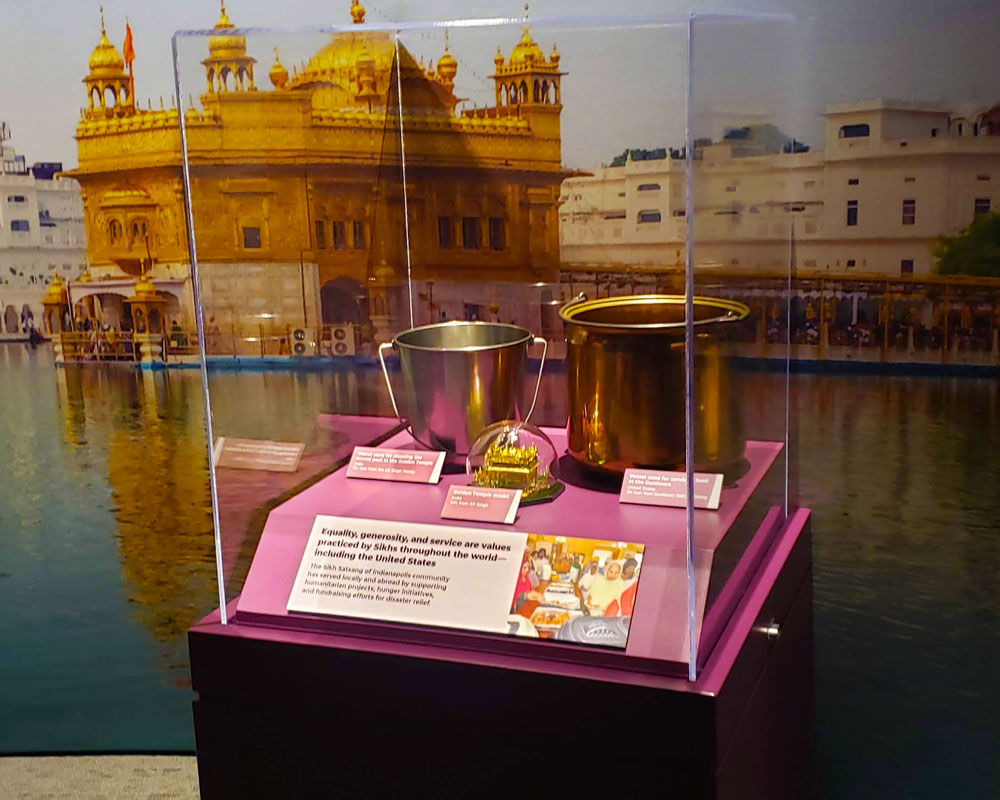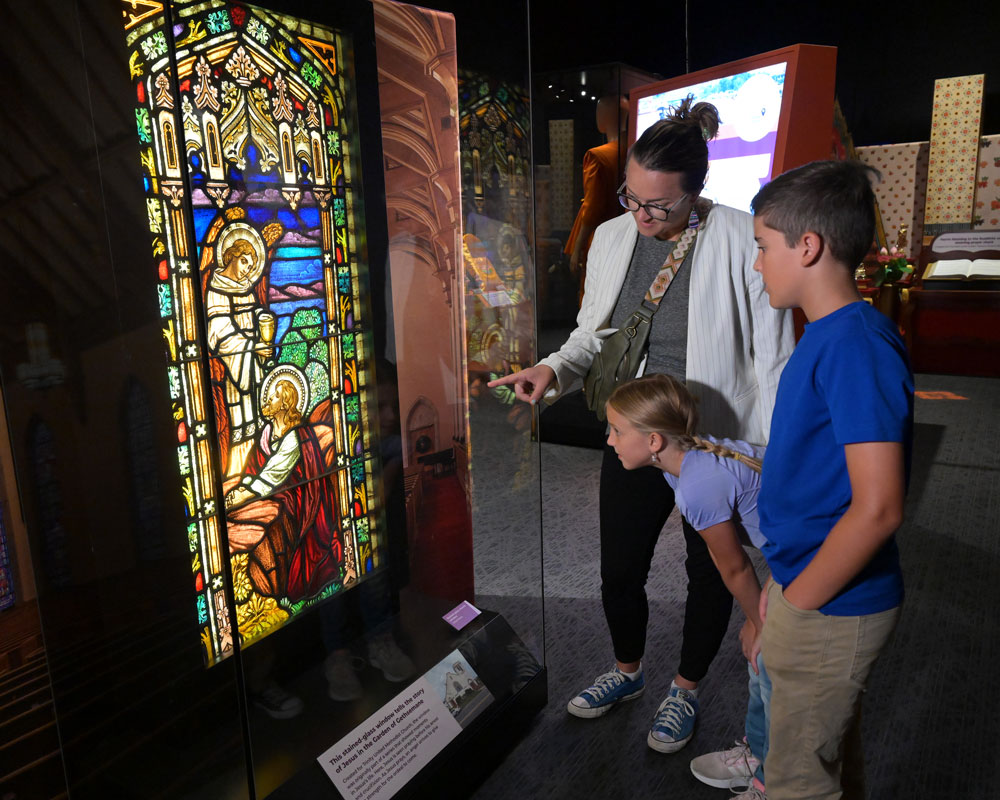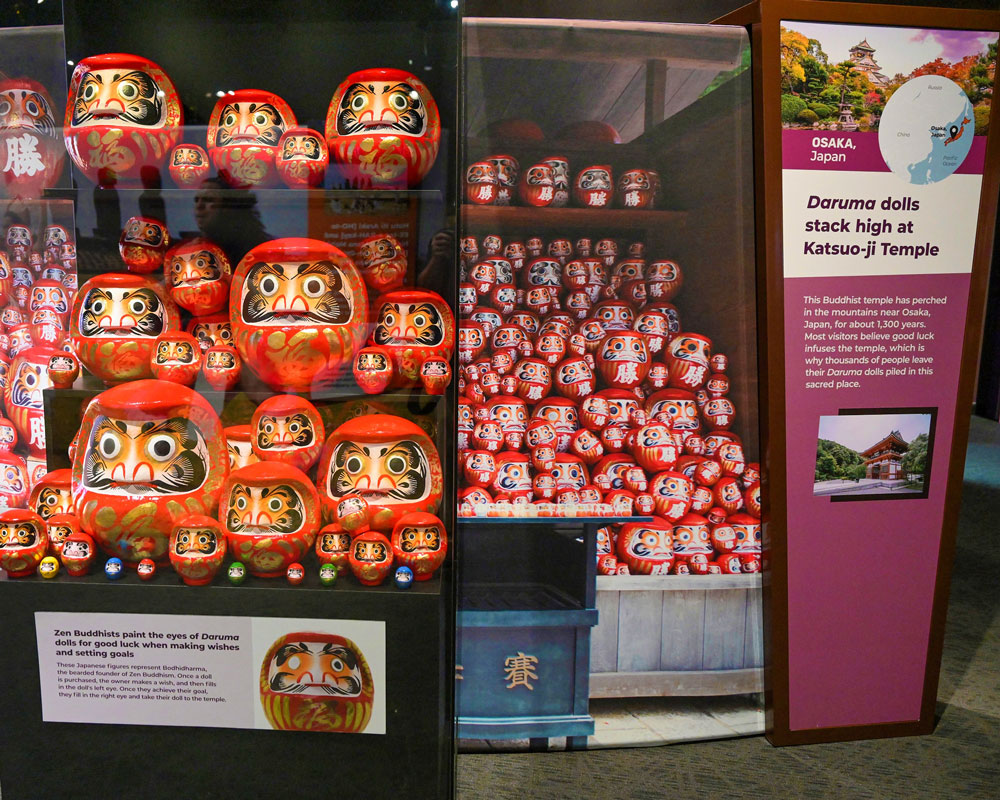We've created a series of posts that discuss how we went about gathering the stories that will shape Sacred Places. This exclusive behind-the-scenes look at covers these topics:
1. The Challenge of Addressing Religion in an Exhibit Like Sacred Places
2. Using Artifacts to Tell Personal Stories
3. Stories Begin with Relationships
4. Weaving It All Together
Religion, faith-based practices, and spirituality are deeply personal topics in many people’s lives. Yes, in many cases there are overarching principles, teachings, and dogmas that define every religious practice. But, in many ways, it really comes down to how each person observes—or doesn’t observe—their religious tradition. It’s highly personal.
How do you create an exhibit that discusses highly personal religious practices, traditions, and rituals in a way that is appropriate for children and engages families?
You tell real stories.
That’s exactly what our exhibit team pursued as they created Sacred Places—real stories of real people having real experiences in their real sacred spaces. We are honored to be able to highlight more than 30 different personal stories in the exhibit. Some are from halfway around the world. Others are from right here within our own neighborhoods. We’re telling six of these stories as immersive environments. They have guides who share about their experiences in their own sacred places:
- Nathan at the Mikvé Israel-Emanuel Synagogue in Willemstad, Curaçao
- Jude at the Beheading of St. John the Baptist Church in Madaba, Jordan
- Aïssata at the Great Mosque of Djenné in Djenné, Republic of Mali
- Shivesh at the Keshav Narayan Temple in Lalitpur, Nepal
- Merahi in Rapa Nui, Chili
- Kaew at Wat Arun in Bangkok, Thailand
You can learn more about these immersive environments in this blog post.
The majority of the stories that we get to share are told through the display of artifacts. What’s an artifact? At its most basic level, an artifact is an object that’s used to tell a story. Because of both brand-new connections—thanks to our collaboration with CyArk—and longstanding relationships with different communities of faith, we are able to tell some deeply personal and powerful stories through the artifacts we have on display. These objects represent a significant role in people’s personal experiences at places they hold sacred. These artifact stories help us see the rich layers of religious practice and spirituality in everyday life.
For many, imagining what objects you’ll find in Sacred Places could conjure up images of ornate ritualistic objects—items like priestly garments, altars, and highly-adorned religious symbols. Of course, those can be part of the religious experience and you’ll find some of these ritualistic objects in the exhibit. But our exhibit team also made an effort to find objects that were personal and helped connect people with their sacred spaces in an intimate way. Because sometimes it’s the ordinary everyday objects that help people feel a connection with their sacred place.
Staying connected from a distance
There are many times when people are physically distant from their sacred places. Artifacts like the ones on display in Sacred Places can help people remain connected to those spaces.
Sikh food vessels
Our exhibit team worked closely with the Indianapolis Sikh community to choose artifacts that represent their connection to their sacred place that’s almost 7,000 miles away. They chose a food vessel because it represents something that is a common challenge in the life of many religious practitioners around the world—how to feel connected to your sacred place when you cannot be near your sacred place.
Sikh pilgrims from around the world journey to the Golden Temple in Amritsar, India. Every day, their community kitchen feeds more than 100,000 people. It’s a great act of service—one that is greatly associated with their sacred place. If you visit the Golden Temple, you will be fed.

After their weekly gathering of prayer and worship, the Sikh community at Gurdwara Sikh Satsang in Indianapolis does the same thing. They sit down and eat. With this act of service, they’re connecting with their sacred place while connecting with each other. With these acts of service, they’re taking their experience and they’re transferring it to their new home, but the experience is very similar. A food vessel that has been used in community meals in the Indianapolis gurdwara is on display in Sacred Places.
Equality, generosity, and service are values practiced by Sikhs throughout the world. Our local Sikh community has served locally and abroad by supporting humanitarian projects, hunger initiatives, and fundraising efforts for disaster relief.
Sacred Places contains other artifacts that reflect this connection with a sacred place from half a world away, including these objects:
Jewish challah board
Israel is cherished by the Jewish people as the land of their religion’s founding and history. Many of the world’s Jewish population, however, lives outside of Israel. Many observers of Judaism express their connection to Israel through art. On display in the exhibit is a challah board from the United States. Challah is a braided bread eaten during the holidays and Shabbat. The board that holds the bread features a view of Jerusalem, Israel—Judaism’s most sacred city.
Muslim prayer rug
A prayer rug on display inside Sacred Places is from a carpet from Al-Masjid an-Nabawi in Saudi Arabia, a mosque built by the Prophet Muhammad. This Islamic pilgrimage site and place of worship is the second-largest mosque in the world. Millions of Muslim worshippers visit each year. Many pilgrims take time to pray outside the tomb of the Prophet Muhammad inside the mosque. Using a prayer rug like the one on display can help some Muslim worshippers feel connected to this sacred site without being there.
Zoroastrian lobandan
Zoroastrian Fire Temples contain a sacred fire that symbolizes the presence of Ahura Mazda, the god of Zoroastrianism. The flames are considered to be a purifying, life-giving element, representing purity and the power of creation. Priests keep these flames eternally burning and worshippers go to the temple to pray and contemplate. There are less than 200 Fire Temples around the world.
Zoroastrian worshippers purify their homes by lighting the lobandan—a container that holds burning embers of coal and wood that are sprinkled with incense. Worshippers take it into each room of their house at sunrise and sunset, filling their homes with a purifying, fragrant smoke that wards off evil spirits and negativity.
Christian stained-glass window
Many Christian churches feature stained-glass windows, which depict stories and symbols from the Bible. This can help to reinforce the community’s stories and beliefs. Some stained-glass windows include scenes from the Holy Land.

The stained-glass window on display in Sacred Places was originally in a United Methodist church in New Jersey. It shows Jesus being visited by an angel in the Garden of Gethsemane. It was originally part of a series of windows that showed moments in Jesus’ life. In the window on display, you can see Jesus being comforted by an angel as he prays before his arrest and crucifixion.
Ceremonial artifacts
Objects used during religious ceremonies, rituals, and traditions can foster deep connections between people and their sacred places.
Model temple chariot model
At Tiruvuvar chariot festival in Tamil Nadu, India, Hindu worshippers honor gods in traveling temples. During these festivals, worshipers pull ornate chariots through the streets, chant hymns, and offer prayers. These chariots carry statues representing the Hindu gods, symbolizing the journey of the gods from their temples to meet the people.

These chariots can be as tall as multilevel buildings and can weigh up to 200 tons. The wheels used to transport them can be the size of a full-grown adult. It takes dozens of worshippers to pull one of these moving temples.
While we don’t have a full-sized chariot from the Tiruvuvar chariot festival, Sacred Places does include a large model of a similar chariot on display.
Model of a torii gate
Followers of Shintoism believe in kami, supernatural beings that inhabit all things, including the sacred mountain peaks, forests, and ocean featured at the Itsukushima Shrine in Hatsukaichi, Japan. The entrance is marked by a torii gate that appears to float on the water.
When visiting a Shinto shrine, travelers look for torii gates. These gates mark the point where the ordinary world ends and the sacred space begins. Inside the gates, worshippers perform ritual offerings to the kami that live in the shrine.
An example of a torii gate is on display in the exhibit.
Dungchen horns
When a low, powerful noise that some say sounds like trumpeting elephants or mooing cows rumbles through the Himalayan Mountains , you know something special is happening. Tibetan Buddhist monks sound dungchen horns as a call to prayer and to support other rituals, including processions and dances.
The dungchen on display in Sacred Places is nearly six feet long. Some of these horns can be as long as 16 feet.
Clothing, jewelry, instruments, and books
Sometimes, people feel connected to their sacred places through what they wear, play, and read.
Muslim hijab
For generations, Meghla Akter’s family has cared for the Ranvijaypur Mosque in Bagerhat, Bangladesh. The mosque is part of the ancient city of Khalifatabad, which is known for its finely made brick monuments. It has served followers of the Islamic faith for about 500 years and is still used by pilgrims around the world as they pray five times a day.
When Meghla leaves the house, she wears a hijab, a head covering used to express modesty and faith. She has graciously gifted the museum with one of her hijabs. “Since I am a Muslim girl, it is not in our Islamic culture to go out just as you like,” she says. “I like different-colored hijabs, so I wear a hijab matching the color of my dress.”
Nigerian bell, jewelry, and drum
The Yorùbá people worship the river goddess, Oṣun, at the Osun Osogbo Sacred Grove in Nigeria. For about 700 years, the community has built shrines in this grove to honor Osun and other Yorùbá deities.The artifacts from this community that are on display in Sacred Places include a bell, jewelry, and a drum, and shares how Chief Priestess Adedoyin Talabi Olosun Faniyii feels when she carries on her community’s tradition.
Hopi kachina dolls
In Hopi Native American culture, kachinas connect humans with the spiritual world.
According to Hopi philosophy, a kachina is a spiritial being. Each kachina represents different aspects of nature, including animals, plants, fertility, and healing. They are credited with teaching the importance of keeping balance and harmony in the universe.
The kachina dolls on display in Sacred Places are not sacred, but are reminders and teaching tools that help people learn about the different kachinas.
Daruma dolls
Zen Buddhists paint the eyes of Daruma dolls for good luck when making wishes and setting goals. Most visitors believe good luck infuses the temple, which is why thousands of people leave their Daruma dolls piled in this sacred place.

How does this happen? After purchasing a doll and painting the left eye, they make a wish and take the doll home. Once they achieve their goal, they fill in the right eye and return it to the temple. Thousands of people have left their Daruma dolls in Katsuo-ji Temple.
The Daruma dolls on display in the exhibit are similar to those left by temple visitors in Japan.
Bahá'í prayer beads and prayer books
Members of the Bahá'í faith community seek to find unity with others. Any work done for the betterment of humanity is considered worship. They read prayers daily from books like the ones on display in Sacred Places.
Christian study Bible
The Bible—a collection of sacred Christian texts considered to be the word of God—is the main book of Christian beliefs and practices. The study Bible on display in I is from the St. James African Methodist Episcopal (AME) Zion Church in Ithaca, New York, one of the first American churches started by a Black congregation. After its founding in 1833, the church was a stop on the Underground Railroad, serving as a transfer point for fugitive slaves en route to Canada. Harriet Tubman is said to have taught Sunday School there. Frederick Douglass also visited this church on several occasions. As the oldest church in Ithaca, St. James AME Zion Church continues to build on its role as a center of the surrounding community.
In 2020, the church worked with Cornell University—another important institution in the Ithaca, New York, community—to uncover more about the church’s role in the Underground Railroad. The team from Cornell encouraged youth from the congregation to participate in some of the excavation efforts. One Saturday afternoon, a professor recounted to our team, they were digging near the building. A funeral was taking place inside the building at the same time.
Because the church building is not air conditioned and it was a very hot day, they had the windows open during the service.The archaeology team made up of college students and local youth could hear the congregation singing while they continued to dig. The professor made a connection—suddenly, what they were doing outside in the abstract became very real when coupled with the voices of a community mourning a loved one. Two centuries ago, this sacred place served as the center of their community. It was the center of the person they were remembering. It continues to be a center today.
As an artifact, the study Bible on display in Sacred Places tells a similar story. In the past, it was used for Sunday School lessons. Now it continues to connect the past with the present, not unlike an archaeological dig in the middle of a funeral.
Sparking a conversation
With billions of people living on our planet, there are billions of personal stories waiting to be told. From the very beginning, our exhibit development team did not seek to create an all-encompassing exhibit about every facet of religious life. They wanted to tell stories—both familiar and unfamiliar. Through the stories told with the artifacts in Sacred Places, we get a glimpse of the rich, deep, beautiful, and diverse experiences people around the world have when they encounter spaces that are sacred to them.
Listen to the stories that are told in Sacred Places. Join the chorus and tell your own. Spark a conversation. You just might discover that even though we have some very significant differences, we have a whole lot in common, too.
Sacred Places was made possible by Lilly Endowment, Inc.
Lilly Endowment Inc. is a private philanthropic foundation created in 1937 by J.K. Lilly Sr. and his sons Eli and J.K. Jr. through gifts of stock in their pharmaceutical business, Eli Lilly and Company. While those gifts remain the financial bedrock of the Endowment, it is a separate entity from the company, with a distinct governing board, staff and location. In keeping with the founders’ wishes, the Endowment supports the causes of community development, education and religion and maintains a special commitment to its hometown, Indianapolis, and home state, Indiana. The principal aim of the Endowment’s religion grantmaking is to deepen and enrich the lives of Christians in the United States, primarily by seeking out and supporting efforts that enhance the vitality of congregations and strengthen the pastoral and lay leadership of Christian communities. The Endowment also seeks to improve public understanding of diverse religious traditions by supporting fair and accurate portrayals of the role religion plays in the United States and across the globe.

 (
(











